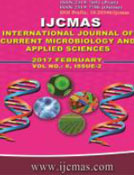


 National Academy of Agricultural Sciences (NAAS)
National Academy of Agricultural Sciences (NAAS)

|
PRINT ISSN : 2319-7692
Online ISSN : 2319-7706 Issues : 12 per year Publisher : Excellent Publishers Email : editorijcmas@gmail.com / submit@ijcmas.com Editor-in-chief: Dr.M.Prakash Index Copernicus ICV 2018: 95.39 NAAS RATING 2020: 5.38 |
A study was carried out to determine the graft compatibility of bitter gourd scions (Palee F1 and CO 1) with ten different cucurbitaceous rootstocks. The grafting technique adopted in this study was side grafting. Graft compatibility was determined by assessing the survival rate of the grafted plants after regeneration of vascular bundles across the graft interface and vegetative growth of the scion. The results on grafting success at 45 days after grating (DAG) revealed that the highest survival percentage (71.70 %) was observed in Palee F1 scion grafted onto pumpkin (Cucurbita moschata) rootstock followed by Palee F1 scion grafted onto sponge gourd (Luffa cylindrica) rootstock (68.26 %) and lowest success per cent (12.12%) was obtained in mithipakal (Momordica charantia var. muricata) (Cucurbita ficifolia) rootstock with CO 1 scion. In order to study the ultra structural changes and compatibility of bitter gourd scions, the anatomical study were conducted in two graft combinations viz., Palee F1 grafted onto pumpkin (C. moschata) rootstock and fig leaf gourd (C. ficifolia) rootstock at four different stages viz., 7th, 15th, 21st and 30th days after grafting. Vascular regeneration across the graft interface was seen in Palee F1 scion grafted onto pumpkin (C. moschata) rootstock. Graft incompatibility was observed in CO 1 bitter gourd scion grafted onto fig leaf gourd (C. ficifolia) rootstock could be attributed to the presence of a necrotic layer at the graft interface. This suggests that pumpkin (C. moschata) rootstock could be the compatible rootstock for grafting with bitter gourd scions.
 |
 |
 |
 |
 |